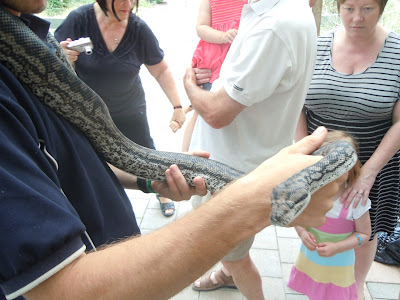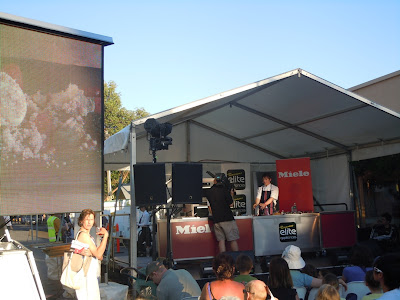The Great Ocean, or GOR, is one of the most scenic routes in the world. It snakes along Victoria's south coast from Warrnambool to Torquay through along some very rugged coastline and through some dense forest. While not the most direct route to Melbourne, it is by far the prettiest.
The GOR was built after World War One as a make-work project for returning veterans. It took many years to complete, even though it isn't really all that long, because the had to blast much of the road from sheer cliffs. It wasn't easy and the GOR is still just a 2-lane coastal highway. However, many of the towns that dot the highway, like Apollo Bay, are now getaways for Melbourne's rich and I guess you could say the whole is sort of like an Australian Riviera or Cote d'Azure.
Isabella and I set out that day hoping for a great adventure. The rains that had plagued us in Queensland and NSW had come down to Victoria. Much of the west of the state was flooded or in danger and I was worried the GOR would be closed. There had been some landslides a few days before and I wasn't sure what the conditions were. As we reached the turnoff, to my great relief the Princes Highway was closed but the GOR was open so we turned and headed south.
The thing about the GOR is that it is made for tourists and there is much to see so travelling is sort of stop-start. The first place Isabella and I stopped was the Bay of Islands, a little inlet with some sheer cliffs. From the lookout you could see that the whole coastline was basically sheer cliffs to the water's edge. The whole area is limestone which erodes and has done so in some odd shapes. Where water had eroded the natural joints in the stone, there were now little islands just off the coast.
From the Bay of Islands, Isabella and I journeyed to the Grotto, an arch in the stone eroded by wind and water. Then it was on to London Arch. This formation was once called London Bridge because it was once connected to the mainland by a bridge of limestone. 20 years ago people could drive their cars directly onto the formation but one day, while some tourists and their vehicle were on it, the bridge gave way stranding them; they had to be rescued by helicopter. From then on, there has been no vehicular access to any limestone formation.
The crown jewels of the GOR, though, arethe 12 Apostles, our next stop. It was here that we saw masses of tourists and even a tourist information center. The 12 Apostles are a series of limestone islands that stand alone in the sea. There have never been 12 of them and there are now 7 or 8 I think as some have been lost due to erosion; eventually they will all collapse. The formation was originally called the Sow and Piglets and was changed to the 12 Apostles purely for reasons of tourism. However, they are spectacular in their own way.
As Isabella and I drove up, there was strange sort of thick mist in the air. I thought it might be smoke from a bushfire but it turned out to be just a sort of fog off the sea. We parked the car and walked to the lookout point and saw the amazing view of the Apostles. A little later, Isabella and I found ourselves the only participants in a free guided tour of the ecology of the Apostles. We were told about the reseeding projects to bring native flora back to the area and even tasted some saltbush. Since this plant gets much of its water from the sea via sea spray, its leaves have a distinct salt taste. Still, nothing could beat that spectacular view, especially on a sunny day.
The 12 Apostles was the last thing to see for a while so Isabella and I drove on. We had heard about a tree top walk in Otway National Park and drove out there. Unfortunately we reached it only minutes after it had closed. A little dejected, we drove to another part of the forest and took a walk through the woods to Triple Falls. The whole area was old growth forest that had once echoed with the din of sawmills. Now long since abandoned, the area has been made into a nice walking trail. The falls themselves were quite nice as the water cascaded down the rock face.
From Triple Falls, we drove to Cape Otway to see the famous lighthouse. When we arrived, it too was closed. It seemed very inconvenient to close things as it was only 18:00 and summertime. Along the way, though, we noticed that there were a few cars parked by the side of the road and then we noticed that everyone was looking at wild koalas. Isabella and I stuck around for a while and took some photos. They were just eating some eucalyptus leaves but for Isabella, who was on a mission to see as many iconic Australian animals as possible, it was quite the experience.
Since the lighthouse was closed, Isabella and I took a walk on some trails in the area. It wasn't particularly interesting as the view to the sea was blocked by dense growth. We though maybe there would be a better view somewhere along the walk but no such luck. With that, we continued east towards Melbourne.
As we drove out of the wild part of the GOR and onto the more developed areas, every so often there was a set of traffic lights. The landslides meant that there were still some boulders on the roads although the road was at least partially cleared. As we drove from town to town, wwe would see people milling about, nice hotels and homes and I definitely got the impression that this was a vacation area for wealthy people, though not exclusively for them.
The GOR ends around Torquay and from there its north to Geelong, Victoria's second biggest city. It was getting quite late as it was already nightfall by the time we reached Geelong. We just drove past it and finally made it to Melbourne. Our couchsurf host this time was a young man living in the very trendy neighbourhood of St. Kilda. We made it to his apartment and I was delighted to show Isabella that even late at night, there were parts of Australia that weren't asleep. We quickly got ourselves sorted before turning in for the night. Melbourne is an exciting city and we would have several days to get to know it.





















































